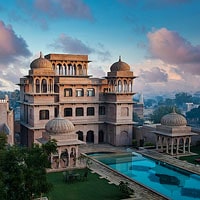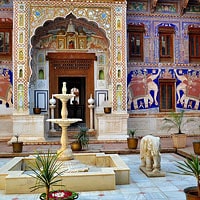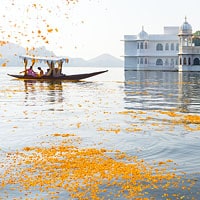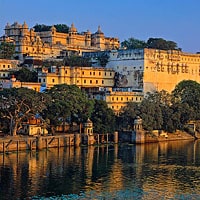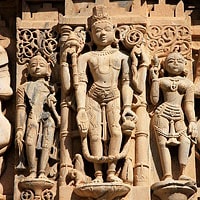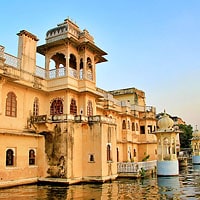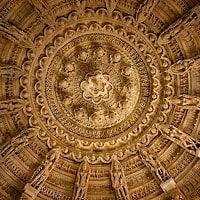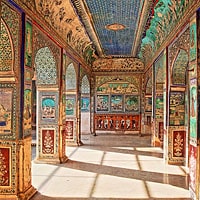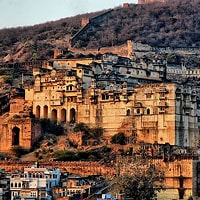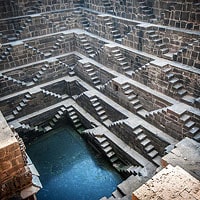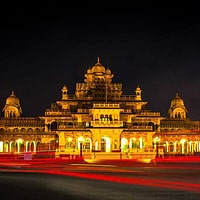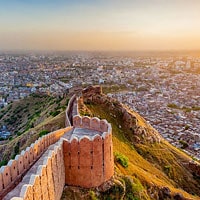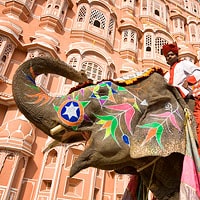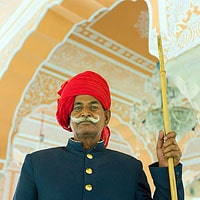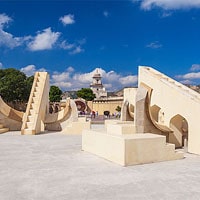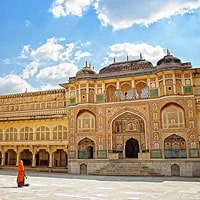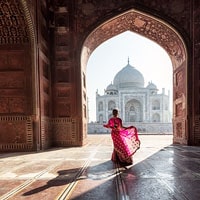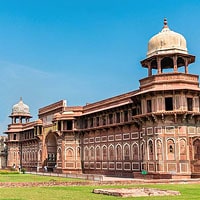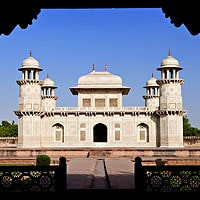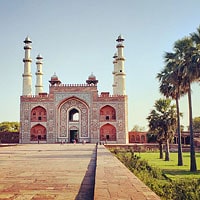Tour name: Rajasthan Tour in 16 DAYS |
|
Tour duration: 16 days |
|
Tour price: from ₹ 79,400 / car |

TOUR OVERVIEW
Day 1: Delhi
Day 2: Delhi - Mandawa (Shekhawati)
Day 3: Mandawa (Shekhawati) - Fatehpur (Shekhawati) - Karni Mata (Temple of Rats) - Bikaner
Day 4: Bikaner - Jaisalmer
Day 5: Jaisalmer
Day 6: Jaisalmer - Jodhpur
Day 7: Jodhpur - Ranakpur Jain Temple - Udaipur
Day 8: Udaipur
Day 9: Udaipur - Mount Abu - Udaipur
Day 10: Udaipur - Chittorgarh Fort - Menal Waterfall & Temples - Bundi
Day 11: Bundi - Pushkar
Day 12: Pushkar - Jaipur
Day 13: Jaipur
Day 14: Jaipur - Chand Baori - Fatehpur Sikri - Agra
Day 15: Agra
Day 16: Agra - Delhi

For more details, check out this Rajasthan map with all the best places to visit.
OPTIONS TO EXTEND OR SHORTEN THE TOUR
+1 DAY |
One extra night and one full day could be added in Shekhawati: this would give you time to discover the villages of Nawalgarh and Mahansar and their beautiful havelis. |
+1 DAY |
One extra night and one full day could be added in Jodhpur: you would have more time to explore the fascinating Blue City and its many attractions. |
-1 DAY |
One night and one full day could be removed in Udaipur: you would skip the day tour to Mount Abu. |
+1 DAY |
One extra night and one full day could be added in Pushkar: you would have more time to see the holy city and you could also visit Ajmer, a famous Muslim pilgrimage site near Pushkar. |
-1 DAY |
One night and one full day could be removed in Agra: you would visit Agra Fort in the afternoon when you reach Agra. The next day, you would visit the Taj Mahal, Itimad-ud-Daulah and Akbar's Tomb; and you would drive to Delhi in the afternoon. |


TOUR ITINERARY
| Day 1: | Delhi
On your first day in Delhi, visit some of the most iconic landmarks. Start your day early and head towards the Red Fort (UNESCO, closed on Monday). This is a historic monument as the Mughals emperors used it as their residence. Then, explore the Jama Masjid. This mosque is so large that it holds over 25,000 people in the courtyard. Next, witness a grand mausoleum, the Humayun’s Tomb (UNESCO). This is the first garden tomb in the Indian subcontinent. After lunch, it’s time to visit Qutb Minar (UNESCO). The towering brick-made minaret looks beautiful against the blue Delhi sky. The last stop is the Lotus Temple (closed on Monday). This symbol of modern Indian architecture is Asia’s only Bahai House of Worship. Tour highlights in Delhi: Red Fort, Jama Masjid, Humayun's Tomb, Qutb Minar, Lotus Temple |
| Day 2: | Delhi - Mandawa (Shekhawati) Driving time: 5 hours, 270 km On the second day, leave the capital city and travel to Mandawa which is located in Rajasthan’s Shekhawati region. Mandawa, a quaint and semi-arid town, is popular for its havelis (merchant’s houses) which are painted beautifully with storytelling art. The walls of the havelis are full of illustrations that narrate a story of the glorious bygone days when the havelis throbbed with life in it. Some of the havelis that are still maintained and are kept open to the public to explore and appreciate their uniqueness are the Jhunjhunwala Haveli, Chokhani Double Haveli, Bansidhar Newatia Haveli, Sneh Ram Ladia Haveli, Gulab Rai Ladia Haveli and Mandawa Castle. When at Mandawa, you can delight your taste buds with some Rajasthani delicacies from various eateries. Tour highlights: Mandawa Havelis and Castle |
| Day 3: | Mandawa (Shekhawati) - Fatehpur (Shekhawati) - Karni Mata (Temple of Rats) - Bikaner Driving time: 4.5 hours, 250 km This morning, drive to Fatehpur and visit Nadine Le Prince Haveli. Formerly known as Nand Lal Devra Haveli, the purchase of it by a French artist, Nadine Le Prince gave the name. She has been in charge of conserving the architecture and artwork of the Rajasthani haveli. After exploring the haveli, leave Shekhawati and head towards Bikaner. Visit the well-known Karni Mata temple. This temple is famous for housing around 25,000 black rats with a few white rats. It is said that if you can spot a white rat, it might prove lucky for you! Tour highlights: Nadine Le Prince Haveli in Fatehpur, Karni Mata (Temple of Rats) |
| Day 4: | Bikaner - Jaisalmer Driving time: 5 hours, 330 km Visit the city of Bikaner. The attractions include Junagarh Fort, Lalgarh Palace, Prachina Cultural Centre & Museum and Bhandasar Temple. Then, drive west towards to the desert city of Jaisalmer. Explore the Golden City and visit the elegant Jaisalmer Fort (UNESCO), which dominates the city. Tour highlights: Bikaner, Jaisalmer Fort |
| Day 5: | Jaisalmer
After breakfast, visit the Jaisalmer Havelis: Patwon ki Haveli, Salim Singh ki Haveli and Nathmal ki Haveli. The traditional decoration of the interiors combined with Rajput-Rajasthani artwork is an outcome of fine architecture. Then drive outside the city and into the Thar Desert where you can enjoy a camel ride in the sand dunes. Spend the end of the afternoon at Gadisar Lake and visit the temples and shrines located around it. A boat ride across the lake while sighting various birds makes a memorable visit. Tour highlights in Jaisalmer: Jaisalmer Havelis, Thar Desert, Gadisar Lake |
| Day 6: | Jaisalmer - Jodhpur Driving time: 5 hours, 280 km Head out of Jaisalmer and arrive at Jodhpur. Here, the first destination is the Old Blue City. This part of the city is dyed with blue paint and is situated at the core of Jodhpur city. The city is one of the ancient cities of India thus, it is full of stories and historical monuments like palaces, forts and temples. The second destination is Umaid Bhawan Palace which is also known as Chittar Palace. The palace reflects elements of Buddhist and Hindu architecture and fine Rajput artworks. Tour highlights in Jodhpur: Old Blue City, Umaid Bhawan Palace |
| Day 7: | Jodhpur - Ranakpur Jain Temple - Udaipur Driving time: 5 hours, 250 km After breakfast, visit the Mehrangarh Fort which offers a wonderful panoramic view of Jodhpur. This 500-year-old fort is guarded by seven walls. Then, visit Jaswant Thada. Built in memory of Jaswant Singh II by his son, the edifice is a memorial of royal families. The life-sized statue of Jaswant Singh on a horse points towards Mehrangarh Fort. Leave Jodhpur and drive to Ranakpur Jain Temple which is well known for its beautiful architecture and refined white marble carvings. Finally, head to Udaipur and spend the end of the day at Lake Pichola, one of the oldest artificial lakes. Tour highlights: Mehrangarh Fort, Jaswant Thada, Ranakpur Jain Temple, Lake Pichola |
| Day 8: | Udaipur
Today is dedicated to the visit of Udaipur. Start with the majestic City Palace whose construction was started by Udai Singh II, the Maharana of Mewar and the founder of the city of Udaipur. A few minutes walk from the City Palace is the Jagdish Temple. The Indo-Aryan style of architecture makes this Hindu temple dedicated to Vishnu unique. Then, visit Bagore Ki Haveli. Settled on the banks of Lake Pichola, the haveli now belongs to the West Zone Cultural Centre (WZCC) that preserves this iconic mansion. Tour highlights in Udaipur: City Palace, Jagdish Temple, Bagore Ki Haveli |
| Day 9: | Udaipur - Mount Abu - Udaipur Driving time: 6 hours, 320 km Today, do a day-trip to Mount Abu from Udaipur. Visit the Dilwara Temples, also known as Delvada Temples. It is a Svetambara Jain Temple that has a rare architectural outlook of simple exterior and intricate aesthetic work filling the interior walls. Then, stroll along the banks of Nakki Lake. Surrounded by lush green hills, the ambience at the lake is calm and relaxing. Tour highlights at Mount Abu: Dilwara Temples, Nakki Lake |
| Day 10: | Udaipur - Chittorgarh Fort - Menal Waterfall & Temples - Bundi Driving time: 4.5 hours, 270 km Drive east to the impressive Chittorgarh Fort (UNESCO), the largest fort in India. The fort was the capital of the Kingdom of Mewar until the 16th century. It is a stunning example of Rajput-Rajasthani architecture. Next, head towards Bundi and stop at the Menal Waterfall and Temples on the way. The waterfall and the Hindu temples dedicated to Lord Shiva are settled in a peaceful hamlet and they are worth the visit. Tour highlights: Chittorgarh Fort, Menal Waterfall & Temples |
| Day 11: | Bundi - Pushkar Driving time: 4 hours, 180 km Explore quiet town of Bundi. First, visit the Garh Palace. What makes this palace unique is that the architecture remained untouched by Mughal influence. Next, head to the Taragarh Fort that that was constructed in the 14th century. Finally, visit the Raniji ki Baori or the Queen's stepwell. The tragic story that led to the construction of the stepwell and its impressive Hindu-Rajput architecture attracts many visitors. In the afternoon, travel to the holy city of Pushkar. Tour highlights in Bundi: Garh Palace, Taragarh Fort, Raniji ki Baori |
| Day 12: | Pushkar - Jaipur Driving time: 3 hours, 150 km In the morning, set out to explore Pushkar and witness some of the oldest temples like the Brahma temples or the Savitri temple and the old ghats of the Pushkar Lake. Then, travel to Jaipur, the capital city of Rajasthan, and visit two prominent landmarks - Albert Hall Museum and Nahargarh Fort. The Albert Hall Museum is the oldest museum in Rajasthan with historical collections like the coins of ancient Gupta and Kushan dynasties and an Egyptian mummy along with many artefacts of different eras. The nearby Nahargarh Fort is your last destination for the day. The fort, on the edge of the Aravalli hills, watches over the city. The panoramic view of the entire Jaipur from this picturesque fort is indeed memorable, especially at sunset. Tour highlights: Pushkar Holy City, Albert Hall Museum, Nahargarh Fort |
| Day 13: | Jaipur
First, visit the Hawa Mahal (Palace of Winds in Hindi). The palace is called so due to winds blowing across it through its 953 windows. Built from red and pink sandstone the palace looks similar to a honeycomb. The City Palace is next in line with its wide courtyard, splendid pavilions and temples and a treasure trove of artefacts held in its mini museum. Next is the Jantar Mantar (UNESCO). It is an ancient observatory with 19 giant astronomical devices. This old astronomical site is home to the largest stone sundial in the world. The last destination for the day is the Amber Palace (UNESCO) also known as Amer Fort. The palace looks impregnable from the outside and hosts some of the best examples of Rajasthan’s architecture within. Tour highlights in Jaipur: Hawa Mahal, City Palace, Jantar Mantar, Amber Palace |
| Day 14: | Jaipur - Chand Baori - Fatehpur Sikri - Agra Driving time: 4.5 hours, 250 km Visit two unique historical attractions on your way to Agra. The Chand Baori, one of India's deepest and largest stepwells, is 13 levels in depth with almost 3,500 steps. Then, visit Fatehpur Sikri (UNESCO). This abandoned city located close to Agra was the capital of the Mughal Empire from 1571 to 1585. The structures of Fatehpur Sikri, constructed from red sandstone, are an impressive amalgamation of Hindu and Islamic styles of architecture. Tour highlights: Chand Baori, Fatehpur Sikri |
| Day 15: | Agra
Start the day by visiting the Taj Mahal (UNESCO, closed on Friday) which is not just a symbol of eternal love but also a model of magnificent architectural work. Then, head to the Agra Fort (UNESCO). Once served as the royal residence of the Mughal families, it is also identified as the Lal Qila. Visit the Baby Taj, the Itimad-Ud-Daulah, a mausoleum that influenced the outlook of the Taj Mahal, and is the resting place of Nur Jahan’s parents. Tour highlights in Agra: Taj Mahal, Agra Fort, Itimad-ud-Daulah (Baby Taj) |
| Day 16: | Agra - Delhi Driving time: 3.5 hours, 230 km As you leave the city of Agra, stop in Sikandra to visit Akbar’s Tomb. The Indo-Islamic mausoleum was built between 1605 and 1613. As you head back to Delhi, you take back with you cherishable moments. Tour highlights: Akbar's Tomb in Sikandra |
TOUR PRICE
- Sedan: ₹ 79,400 / car
- SUV: ₹ 107,400 / car
See our car models.
The price includes:
✓ Driver (English-speaking)
✓ Car
✓ Fuel
✓ Tolls and parking fees
✓ Driver’s food and accommodation
✓ Taxes
The price excludes:
✗ Meals and hotels
✗ Entrances tickets to monuments
You can book hotels on your own, or we can handle the bookings for you.






